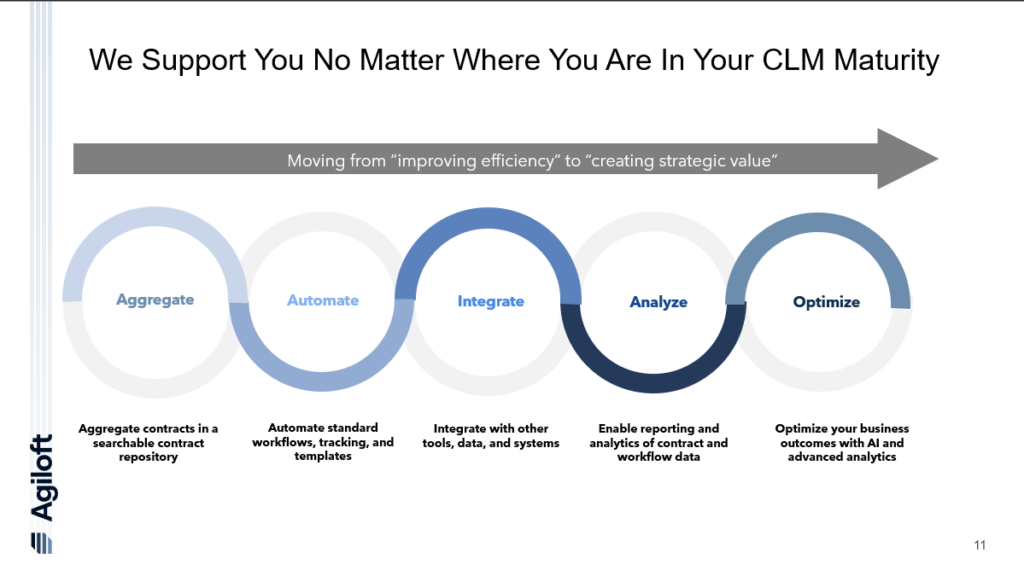
Assessing CLM maturity: From improving efficiency to creating strategic value
Hear directly from Agiloft users as they discuss how to identify their place in the CLM Maturity Model, and when to take the next step.

In May, Agiloft users got together at their regular coffee chat to discuss the Contract Lifecycle (CLM) Maturity Model, assessing their CLM maturity, and where they ultimately wanted to be – but the conversation focused heavily on one specific question: how do you know when you’re ready to take the next step?
The CLM Maturity Model
First, let’s take a look at the CLM maturity model as a whole:

This maturity model focuses on your journey utilizing CLM to its fullest potential, from using a contracting system as a simple document repository, to creating an end-to-end smart contracting workflow that can serve to make a true impact on overall business operations.
Transform from improving efficiencies to creating strategic value
Read on to learn more about each stage of this journey, how Agiloft users are approaching assessing CLM maturity, and when and how to take the next step towards optimization.
Aggregate
The first stage in our maturity model, and often a triggering need for CLM is a whole is aggregation. Before you can act on the data found in your contracts, you must be able to find them. Oftentimes, the aggregation, automation and even sometimes integration phases of the maturity model can experience initial overlap, so how do you know when to feel confident in your new contract repository and can comfortably focus on the more strategic features of your CLM solution?
The repository is the foundation in which your CLM is built, so it’s important to take your time with the setup.
One Agiloft user mentioned treating this phase as “publicity mode,” and suggested things like holding office hours for internal users and creating short videos for vendors. While these initial meetings are happening, you can ask questions and get feedback that will jumpstart the planning for the next few phases.
One user mentioned they truly felt like they had reached their phase one goal when a more tech-impaired user said to them, “I know I might not be finding it fast, but I know I can find it.” The peace of mind had been instilled – onto the wowing.
Automate
Workflow: the next natural and vital stage of the CLM maturity journey. It’s the first major step towards the end goal of creating strategic value across the organization and can make major business impact, but often it includes opening your CLM instance to the wider organization.
One current user decided the direct method was best. Once their new automated workflow was in place, they changed the approval policy, and the new workflow was mandated. While this can be an abrupt change, it opens the door to having conversations directly with those that aren’t following the new policy.
As far as deciding when you’re ready for a new stage? Numbers don’t lie – you can now rely on metrics to show exactly how your automation is affecting the broader organization, which helps build a business case on why you should integrate this system with the other foundational systems that other departments use in their day-to-day lives.
For example, after one organization implemented their new automated workflow, they were able to definitively prove that what was originally assumed to be a bottleneck stopgap in the legal department was actually a traffic jam in the finance department. Moving forward, they were able to put new procedures in place that reduced the number of contracts that needed to go through the finance team – significantly improving their contract processing time.
Once this shift happened, the finance department sought other integrations, creating a natural progression to the next step of CLM maturity. As the user said, ““someone is getting excited about my system. It might mean more work for me right now, but in the long run what it means is more clicks, more using, more usefulness.”
Integrate
Integrations were an interesting shift in the discussion – mainly around the differentiating thoughts of when it’s most appropriate to think – and then ultimately act – on integrating your CLM.
Beyond the systems that will be an integral part of the contract lifecycle itself, what about liberating that contract data and integrating it with broader technologies across the organization? One power user mentioned starting their implementation from the get-go with the intention that within the first 6-8 months, the integration work would be complete. If you don’t have a strict timeline in mind, it often comes naturally.
Now that users across the organization have been involved with focus groups or have used the tool themselves, they want more. Which brings us to the age-old adage: “just because you can doesn’t mean you should.”
One of Agiloft’s defining standouts is the flexibility and sheer mass of potential workflows you can create in the system – but should you?
It’s important to remember not to overload the system. One user used this as their guiding motivation for integrations.
Analyze
This step in the maturity model is where you get to showcase those benefits that your users are already experiencing. You’ve heard how people are being asked to create new workflows, add new integrations, and more – maybe some of this is even due to your analysis.
One user shared the first time they were able to show the demonstrable reduction in time to approve contracts, the overwhelming sentiment was “what else can we automate?” Which is exactly where you want to be when you’re looking forward to moving on to the next stage – optimization.
What about usage or satisfaction analysis? While broad office hours or satisfaction surveys seemed to work well to get an overarching consensus on how the larger group are feeling about your new system, a new concept was introduced at this part of the discussion: focus groups. One member of the roundtable mentioned that she built a focus group of ~10-14 users that meet on a quarterly basis to foster candid discussions on how they’re using CLM – its benefits and hinderances, any improvements they might have to suggest, and more.
Focus groups are also an opportunity to visualize your entire CLM wish list as a group, moving things up and down the priority list so you can ensure you are continuing to grow and remaining on the track to full maturity. In this instance, the user created these groups as invite-only to build exclusivity and passion for the project. This subsequently helped them build buy-in and adoption from each member that trickled down to their respective departments.
Optimize
Now that your CLM has reached this stage – what’s next – what is true optimization? This roundtable discussion opened with our internal Agiloft proctor discussing AI initiatives and mentioned that almost every client she’d connected with in 2024 had leadership with AI as a top priority for this year. This is what true CLM optimization looks like – taking the automation and reporting you’ve already implemented to the next level, with even fewer steps, and an even larger strategic impact across the entire business.
The Takeaways
Ultimately, the journey through the Contract Lifecycle Management (CLM) Maturity Model is a transformative process that not only enhances operational efficiency but also fosters strategic growth within an organization. From the foundational aggregation stage to the pinnacle of optimization, Agiloft users have demonstrated that a methodical and metrics-driven approach to assessing CLM maturity is key to advancing through each phase. The shared experiences highlight the importance of user engagement, from office hours to focus groups, ensuring that every step is grounded in practical feedback and real-world impact.
As organizations navigate the complexities of automation, integration, and analysis, the goal remains clear: to leverage CLM as a dynamic tool that drives business innovation and delivers tangible value. With AI initiatives on the horizon, the path to true optimization is not just about streamlining processes but about envisioning a future where CLM solutions are integral to the broader business ecosystem, empowering users to achieve more with less and propelling organizations towards a smarter, more connected operational framework.
Recent
Posts
Learn about the realities of AI today, its limitations and capabilities, and its use as a “force multiplier” for contracting.
If there is one message for tech buyers as we approach 2024, it is that AI is here – ready or not.
With the introduction of ConvoAI, Agiloft delivers the same benefits of simplified AI experiences to the world of contracts.





